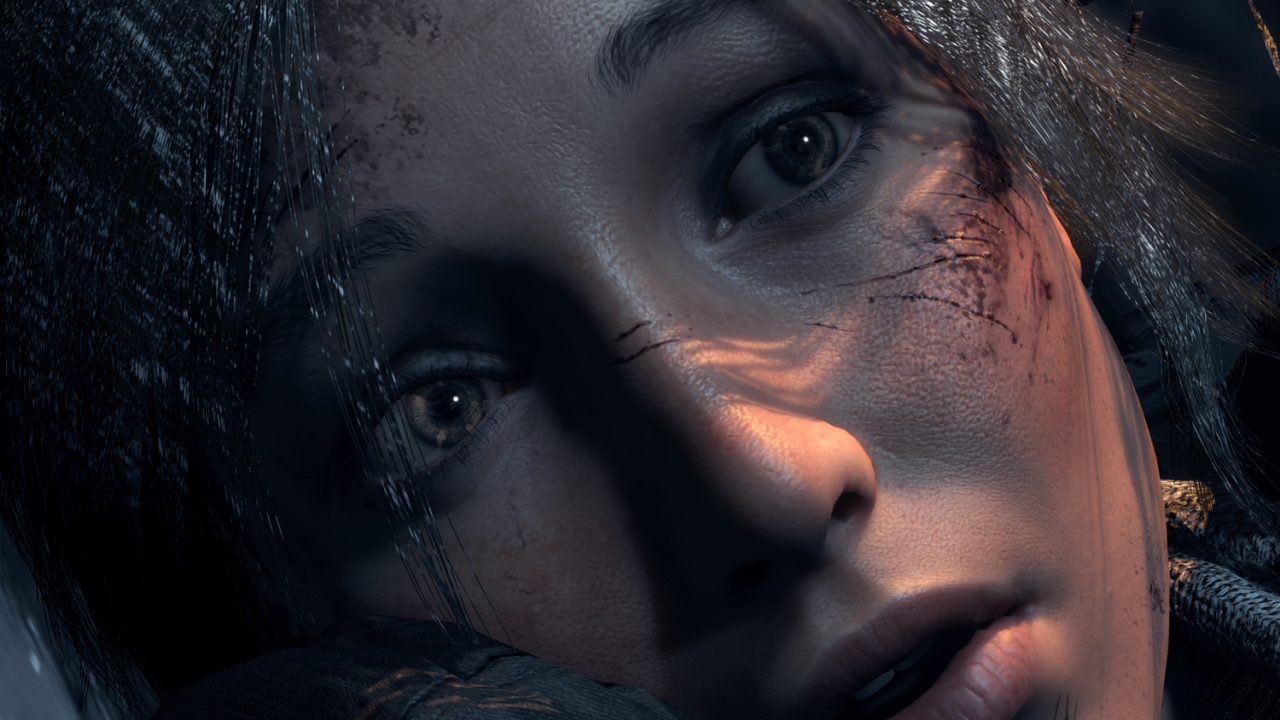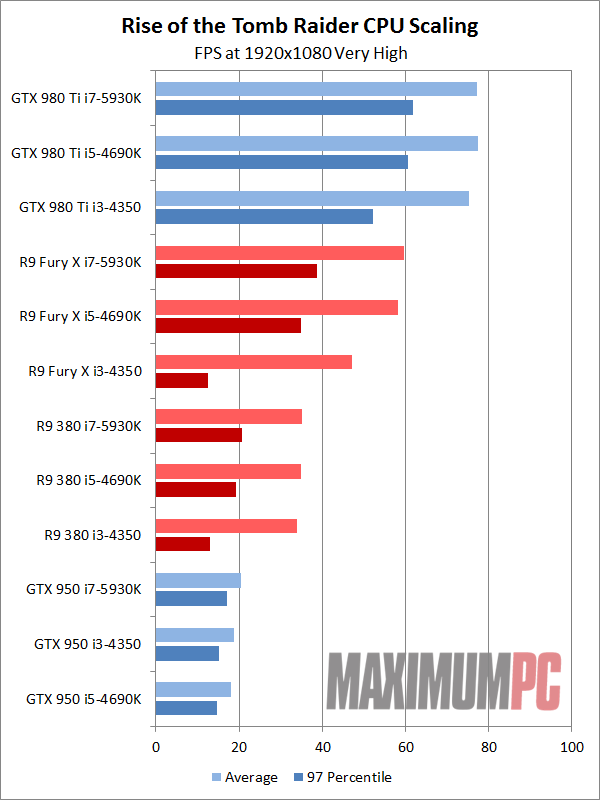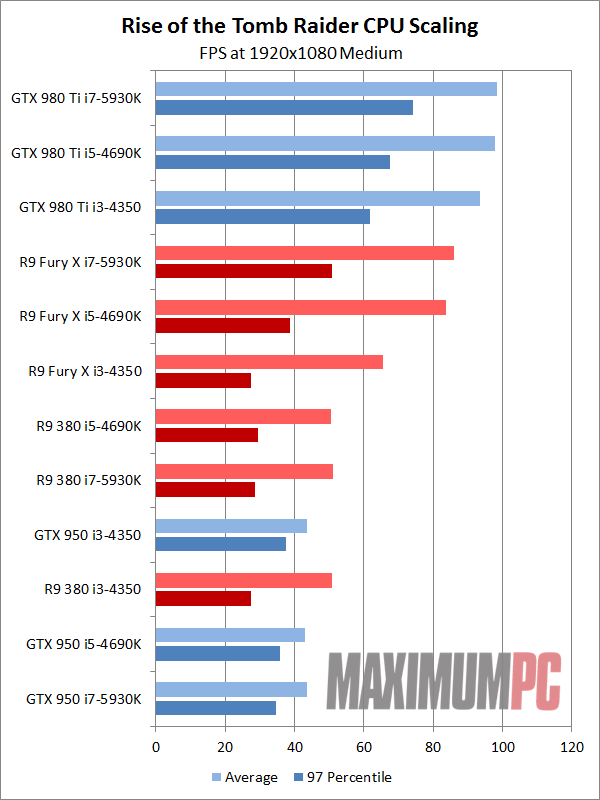Benchmarked: Rise of the Tomb Raider

Brain taxidermy
Terrible puns aside, we also wanted to look at how a few of the GPUs scale with lesser CPUs. As noted earlier, we're using a single CPU to simulate two other CPUs. It's not going to be exact, but it should be close enough for our purposes. If a game is predominantly GPU limited—which was the case with 2013's Tomb Raider reboot—then any decent CPU will prove sufficient. We've tested the 1080p Very High and Medium presets this round, and we're looking at the 980 Ti and Fury X at the top of the GPU totem pole (basically, removing GPU limits from the equation as much as possible), with the R9 380 and GTX 950 representing mainstream parts.

Yikes! Did we mention AMD needs to work on tuning their drivers for this particular title yet? The i7-5930K and i5-4690K are at least somewhat close, and the R9 380 doesn't do too badly with the i3-4350, but the Fury X takes a swan dive when paired with the dual-core processor. That's not encouraging, and hopefully it isn't too difficult to fix. Then again, we doubt many users are looking at running a Fury X with a budget Core i3 processor.
Nvidia for their part shows far more reasonable scaling. The 6-core i7-5930K wins out overall, which it should considering it's also running a higher clock speed, but the i5-4690K isn't far off, and neither is the i3-4650. There's a bit more choppiness with the Core i3 configuration, but overall you should be fine with any single Nvidia GPU matched with any recent Core i3 or higher Intel CPU. We had hoped to check out AMD APUs/CPUs as well, but time is not on our side—perhaps we'll check that aspect once drivers are up to snuff.

Dropping to Medium quality puts more of a burden on the CPU, at least for the faster GPUs. Average frame rates on Nvidia remain relatively consistent, but minimums show a clear progression when moving from i3 to i5 to i7 parts. You could still use a 980 Ti with a Core i3 and not worry much, but again we expect most people plunking down $650 on a GPU will have at least a Core i5 processor, and more like a Core i7.
The R9 380 again has very stable results, but the Fury X is seriously handicapped by the dual-core processor—and Hyper-Threading doesn't appear to help. This is one of those items that DirectX 12 should help alleviate, as the CPU bottleneck will be reduced, but these CPU charts certainly paint AMD's drivers in a less than kindly light. Now we just need to wait and see how long it takes for AMD to rectify the situation.
Tracking the Divine Source
We've had plenty to say about performance and drivers, but the short summary right now is that Nvidia has a clear lead. That's not really a shock, given the Nvidia branding and Game Ready driver, but in an ideal world we'd see "Game Ready" drivers from all contenders on every major launch. With AMD's new Crimson drivers and a stated increased focus on all things Radeon (from the Radeon Technology Group), things are getting a bit better but AMD isn't out of the woods yet.
Interestingly, despite the Nvidia branding, AMD definitely had at least some influence on Rise of the Tomb Raider. This is the first game to come out using Eidos' new PureHair library. AMD had Eidos present at their RTG Summit last December, and one of the points of their presentation was how Eidos was able to take AMD's open source TressFX and modify it as they saw fit. The result is PureHair, which is supposedly optimized to work even better for things like animating Lara's ponytail. Considering how much time you'll spend looking at Lara's head, it's a far more noticeable graphics effect than HBAO+ in our opinion.
The biggest gaming news, reviews and hardware deals
Keep up to date with the most important stories and the best deals, as picked by the PC Gamer team.
As for Rise of the Tomb Raider, the game is treading familiar ground in terms of Lara Croft and her spelunking activities, but the reboot definitely helped to breathe new life into the series. There have been several other good games that overlap with Tomb Raider in a variety of ways—the hunting and crafting of the Far Cry series, for instance, definitely gives a feeling of déjà vu—but that's not a bad thing. PC Gamer scored Rise of the Tomb Raider at 83, and their full review is definitely worth a read if you haven't checked it out. This isn't a series known for innovation (other than the original game back in 1996, perhaps), but it's still good fun, and the graphics are better than ever. Sometimes, that's all you really want, and we can think of far worse ways to spend a weekend.
Jarred's love of computers dates back to the dark ages when his dad brought home a DOS 2.3 PC and he left his C-64 behind. He eventually built his first custom PC in 1990 with a 286 12MHz, only to discover it was already woefully outdated when Wing Commander was released a few months later. He holds a BS in Computer Science from Brigham Young University and has been working as a tech journalist since 2004, writing for AnandTech, Maximum PC, and PC Gamer. From the first S3 Virge '3D decelerators' to today's GPUs, Jarred keeps up with all the latest graphics trends and is the one to ask about game performance.


